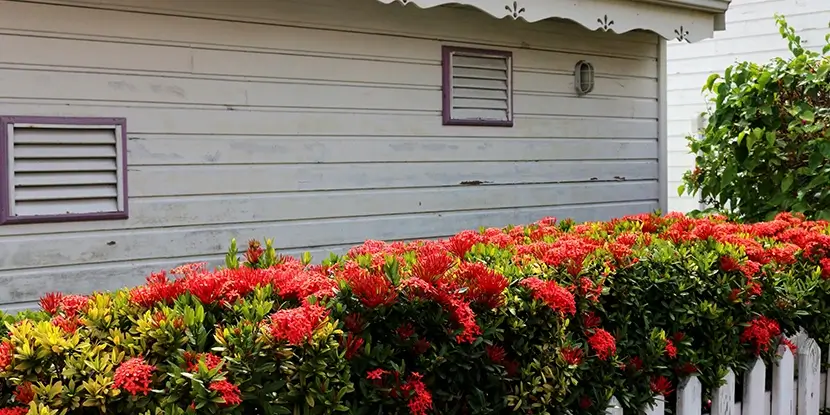Southern California is blessed with warm weather most of the year. Winters are mild.
These conditions allow for many tropical blooming plants in our landscapes. One such plant is ixora, of which Jungle Geranium is the most common variety.
Ixoras are lush, large-leaved shrubs that produce rounded clusters of star-shaped blooms. These clusters can grow 7 to 8 inches in diameter and are scattered randomly throughout the plant. They appear on the tips of new upright stems and are readily visible and fully exposed to the sun.
Coming in all colors and sizes, ixoras bloom best when it’s hot. They take most of the spring to put on new growth and produce flower buds. Once flowering begins, you’ll enjoy a panorama of color all summer.
An ixora hedge lining the fence of a house.
Ixora Varieties
- Jungle Geranium is the most common variety, with vibrant red flowers and glossy green leaves. It can grow up to 10 feet tall.
- Super King has bright orange-red flowers and grows to about 6 feet tall.
- Maui is a dwarf variety that grows only 3 to 4 feet tall. It has pink or salmon-colored flowers and smaller, more compact leaves.
- Nora Grant has large, deep pink flowers and can grow up to 8 feet tall.
- JG Yellow produces butter yellow blooms on a shorter, compact shrub.
- Dwarf Ixora, or Taiwan-ensis, comes in red, yellow, pink, and orange. It’s ultra-compact, often growing to no more than 8 to 10 inches. It blooms profusely but is slow to re-bloom. If space is a problem, try this compact tropical jewel.
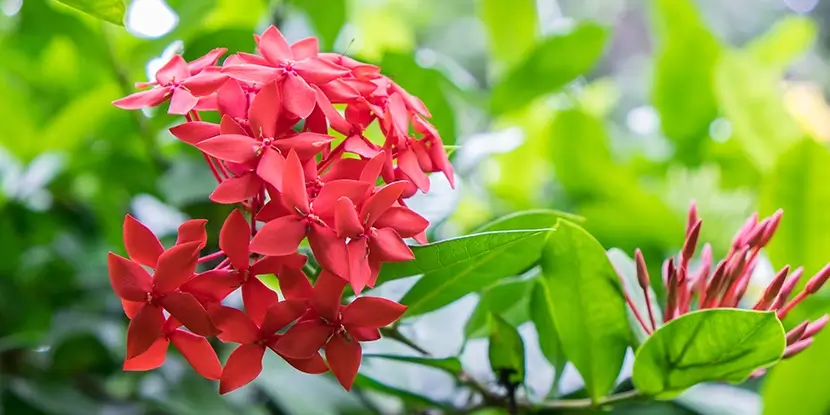
Red ixora blooms and buds.
Planting Ixora
- Plant your ixora in a sunny, raised area, using plenty of planting or soil mix to raise the bed’s level.
- Dig a hole 1.5 to 2 times wider than the root size but no deeper than the original pot.
- Rest the root system on the undisturbed soil at the bottom of the hole and fill around the roots with your prepared bed mixture.
- Water your new plant with a root stimulator, following the directions on the label.
- If a trellis is necessary or desired, install it no more than 12 inches away from the plant so that it will be available for support.
Watering Ixora
Ixoras are very sensitive to drying out and should be watered regularly and thoroughly.
- Newly Planted Ixoras: Water immediately after planting and then daily for the first week to help establish the roots.
- Established Ixoras: Water deeply once or twice a week, depending on weather conditions and soil type. Ensure the soil remains moist but not soggy.
- During Hot Weather: Increase watering frequency to 2-3 times per week during particularly hot and dry periods to prevent the soil from drying out completely.
- Rainy Season: Reduce watering frequency during rainy seasons.
- Indoor Ixoras: Water when the top 1-2 inches of soil feels dry. Be careful not to overwater, as indoor plants generally need less water than those grown outdoors.
- Mulching: Apply mulch around the base of the plant to retain moisture.
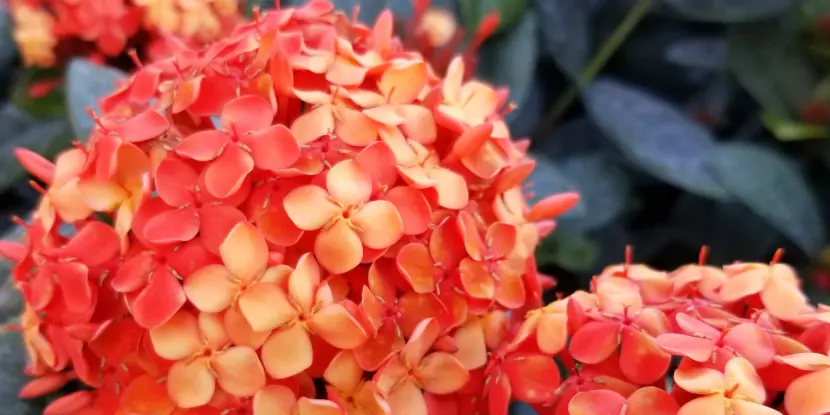
Orange-colored Maui Ixora flowers that attract butterflies.
Fertilizing Ixora
Hibiscus fertilizer is formulated for many tropical blooming plants, including ixora. It offers the correct balance of leaf-inducing nitrogen, bloom-promoting phosphorus, and vigor-imparting potassium. Follow this schedule for healthy growth and abundant blooms:
- Spring: Begin fertilizing as new growth emerges. Apply a balanced, slow-release fertilizer or a specific hibiscus fertilizer following the package instructions.
- Late Spring/Early Summer: Feed the plants once more as they begin to form flower buds. This helps support robust blooming.
- Mid-Summer: Apply another round of fertilizer to maintain flowering throughout the summer.
- Late Summer/Early Fall: Conduct the final feeding of the year. This helps the plant store nutrients for the winter.
Regular feeding every 6-8 weeks during the growing season supports healthy leaf growth and continuous blooming. Water the plant well after each application to push nutrients to the root system. Avoid fertilizing in late fall and winter when the plant is dormant.
Insects & Diseases
Like many tropicals, ixoras are susceptible to mealy bugs and spider mites.
- Insecticidal soaps and sprays can help (follow all directions on the manufacturer’s label).
- Neem oil, a natural insecticide, can also effectively treat pests.
- To prevent disease, avoid over-watering and try to keep the foliage dry.
- Avoid using overhead sprinklers when watering to reduce the risk of leaf spot diseases.
- If leaf spots appear, remove any infected leaves and treat with a fungicide if necessary.
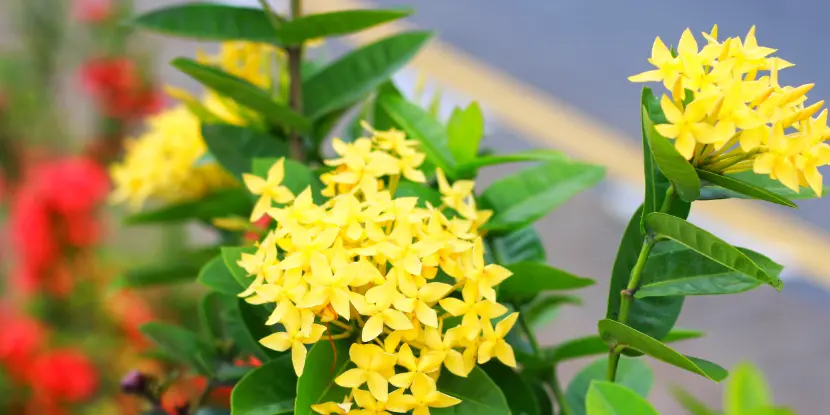
Yellow jungle geranium in a garden.
Pruning Ixora
Pruning ixora plants promotes healthy growth, improves their shape, and encourages more prolific blooming.
- Prune ixora in late winter or early spring before the new growth starts.
- Use clean, sharp pruning shears or scissors to make precise cuts. To prevent the spread of disease, sterilize the tools with alcohol or a bleach solution.
- Begin by cutting away any dead, damaged, or diseased branches.
- Cut back any overly long or unruly branches to maintain the desired shape and size of the plant. Make the cuts just above a leaf node or bud to encourage new growth.
- Remove some of the inner branches if the plant is too dense. This allows better air circulation and light penetration.
- For a fuller, bushier plant, pinch back the tips of new growth. This encourages the plant to branch out more and produce more blooms.
Winter Protection
Growing ixora in containers gives you more control over growing conditions. For instance, you can offer winter protection by moving the container into a garage, installing drip irrigation in individual pots, and applying soluble fertilizers.
- Outdoors: If temperatures are expected to drop below 50°F (10°C), cover the plant with a cloth or plastic sheet to provide frost protection.
- Potted Ixoras: Bring indoors and place in a sunny location until spring. Reduce watering, but don’t allow the soil to dry out completely.
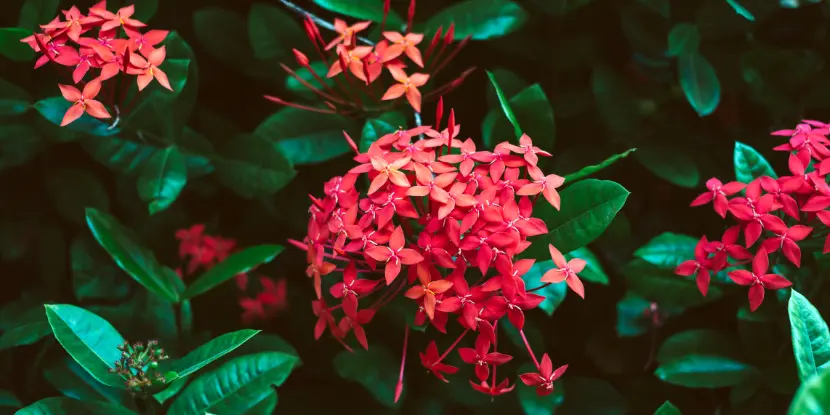
The vibrant red flowers of an ixora plant.
FAQs: Ixora Plant Care
Q: How often should I water my ixora plant?
In Southern California’s climate, water your ixora weekly. If the soil dries out quickly in summer, you may need to water it more often.
Q: What’s the best soil for ixora in Southern California?
Ixora thrives in slightly acidic to neutral soil rich in organic matter. To maintain the correct pH balance and soil structure, amend the soil with peat moss or compost.
Q: Do ixora plants need a lot of sunlight?
Ixora plants require full to partial sunlight, so choose a location where they can receive at least 4 to 6 hours of direct sunlight daily.
Q: How can I protect my ixora from the harsh afternoon sun?
Provide light shade during the peak afternoon hours, especially in the hottest summer months, to protect it from potential sunburn.
Q: When is the best time to fertilize ixora, and what type should I use?
Fertilize during the growing season, from spring through fall. Use a slow-release fertilizer high in nitrogen to encourage lush foliage and flowering.
Q: Are there any specific pests to watch out for with ixora?
Keep an eye out for pests like aphids and spider mites. Regular inspection and prompt use of insecticidal soap or neem oil can control these pests.
Q: How do I manage the watering needs of ixora during a drought?
Prioritize water conservation by using mulch to retain soil moisture. Water early in the morning or evening to reduce evaporation.
Q: Can ixora be grown in containers?
Yes, if the pot has good drainage. Use a potting mix suitable for acid-loving plants.
Q: How should I prune ixora to maintain its shape and health?
Prune in late winter or early spring before new growth begins. Remove dead or diseased branches, and shape the plant to encourage denser foliage.
Q: Is ixora resistant to diseases, or should I be concerned about specific ones?
Ixora can be susceptible to fungal diseases if overwatered or planted in poorly draining soil. To mitigate the risk, follow proper watering techniques and ensure good air circulation.


